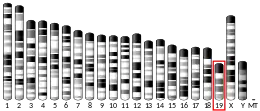Homeobox protein Nkx-2.3 is a protein that in humans is encoded by the NKX2-3 gene.[5][6][7]
NKX2C is a member of the NKX family of homeodomain-containing transcription factors, which are implicated in many aspects of cell type specification and maintenance of differentiated tissue functions.[7]
References
- 1 2 3 GRCh38: Ensembl release 89: ENSG00000119919 - Ensembl, May 2017
- 1 2 3 GRCm38: Ensembl release 89: ENSMUSG00000044220 - Ensembl, May 2017
- ↑ "Human PubMed Reference:". National Center for Biotechnology Information, U.S. National Library of Medicine.
- ↑ "Mouse PubMed Reference:". National Center for Biotechnology Information, U.S. National Library of Medicine.
- ↑ Price M, Lazzaro D, Pohl T, Mattei MG, Ruther U, Olivo JC, Duboule D, Di Lauro R (Mar 1992). "Regional expression of the homeobox gene Nkx-2.2 in the developing mammalian forebrain". Neuron. 8 (2): 241–55. doi:10.1016/0896-6273(92)90291-K. PMID 1346742. S2CID 22766848.
- ↑ Pabst O, Schneider A, Brand T, Arnold HH (Jul 1997). "The mouse Nkx2-3 homeodomain gene is expressed in gut mesenchyme during pre- and postnatal mouse development". Dev Dyn. 209 (1): 29–35. doi:10.1002/(SICI)1097-0177(199705)209:1<29::AID-AJA3>3.0.CO;2-Z. PMID 9142493.
- 1 2 "Entrez Gene: NKX2-3 NK2 transcription factor related, locus 3 (Drosophila)".
Further reading
- Harvey RP (1996). "NK-2 homeobox genes and heart development". Dev. Biol. 178 (2): 203–16. doi:10.1006/dbio.1996.0212. PMID 8812123.
- Pabst O, Zweigerdt R, Arnold HH (1999). "Targeted disruption of the homeobox transcription factor Nkx2-3 in mice results in postnatal lethality and abnormal development of small intestine and spleen". Development. 126 (10): 2215–25. doi:10.1242/dev.126.10.2215. PMID 10207146.
- Phiel CJ, Gabbeta V, Parsons LM, et al. (2001). "Differential binding of an SRF/NK-2/MEF2 transcription factor complex in normal versus neoplastic smooth muscle tissues". J. Biol. Chem. 276 (37): 34637–50. doi:10.1074/jbc.M105826200. PMID 11457859.
- Biben C, Wang CC, Harvey RP (2003). "NK-2 class homeobox genes and pharyngeal/oral patterning: Nkx2-3 is required for salivary gland and tooth morphogenesis". Int. J. Dev. Biol. 46 (4): 415–22. PMID 12141427.
- Strausberg RL, Feingold EA, Grouse LH, et al. (2003). "Generation and initial analysis of more than 15,000 full-length human and mouse cDNA sequences". Proc. Natl. Acad. Sci. U.S.A. 99 (26): 16899–903. Bibcode:2002PNAS...9916899M. doi:10.1073/pnas.242603899. PMC 139241. PMID 12477932.
- Deloukas P, Earthrowl ME, Grafham DV, et al. (2004). "The DNA sequence and comparative analysis of human chromosome 10". Nature. 429 (6990): 375–81. Bibcode:2004Natur.429..375D. doi:10.1038/nature02462. PMID 15164054.
- Gerhard DS, Wagner L, Feingold EA, et al. (2004). "The Status, Quality, and Expansion of the NIH Full-Length cDNA Project: The Mammalian Gene Collection (MGC)". Genome Res. 14 (10B): 2121–7. doi:10.1101/gr.2596504. PMC 528928. PMID 15489334.
This article incorporates text from the United States National Library of Medicine, which is in the public domain.
This article is issued from Wikipedia. The text is licensed under Creative Commons - Attribution - Sharealike. Additional terms may apply for the media files.



